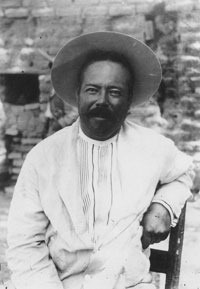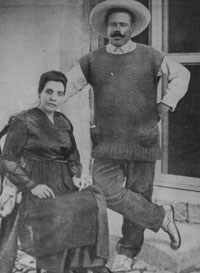PANCHO VILLA (1877-1923)
Born Doroteo Arango in Durango, Mexico, Francisco "Pancho" Villa became a fugitive at the age of sixteen. The son of a sharecropper, Arango returned home from the fields one day to discover that the hacienda owner was about to rape his twelve-year-old sister. He picked up a pistol, shot the landowner, and escaped on horseback. Little is known about his activities for the following four years except that he became involved with some cattle rustlers and adopted the name of a notorious bandit. By the time he was twenty years old, Villa had moved to Chihuahua, where he worked in the mines and rustled cattle on the side. Two years later, he added bank robbery to his list of accomplishments. The charismatic leader and his band of supporters moved to the sierras and cultivated a reputation for social banditry: they were renegades of the wilderness who thwarted Porfirio Díaz's brutal rurales and often provided the suffering peasantry with food.
In 1910 he came out of hiding to join Francisco Madero's movement to overthrow the Díaz government. Villa used his natural charm to convince thousands of men to join the cause and to establish the División del Norte, which included an entire squadron of Americans. His military campaigns were victorious throughout Mexico. Madero was successfully empowered, but rival Victoriano Huerta quickly had him assassinated and seized power. Huerta had imprisoned Villa, but the commander of the División del Norte escaped and made his way to El Paso, where he recruited supporters and plotted the overthrow of Huerta. His unorthodox exploits and undeniable charm captured the imagination of U.S. newsmen and Hollywood producers alike, who rushed to Mexico in droves to record his battles, some of which were staged for their benefit.
Villa maintained control over northern Mexico throughout the revolution, financing his army through cattle rustling. Border towns in the United States provided eager markets for beef, and some merchants enthusiastically sold him arms. The flagging Mexican economy didn't impede Villa: he simply issued his own money and threatened to kill those who hesitated to take it. When the United States government openly supported Venustiano Carranza's bid for power, Villa was incensed and retaliated by raiding towns along the border, including Columbus, New Mexico. While Americans were aghast, many Mexicans saw the raids as justified retribution against their yanqui oppressors.
The U.S. Army sent punitive expeditions into Mexico in 1916 and 1919 but failed to defeat Villa. Finally, he surrendered his forces to the Mexican government in 1920 and retired to Canutillo, Durango. He was assassinated in 1923.
